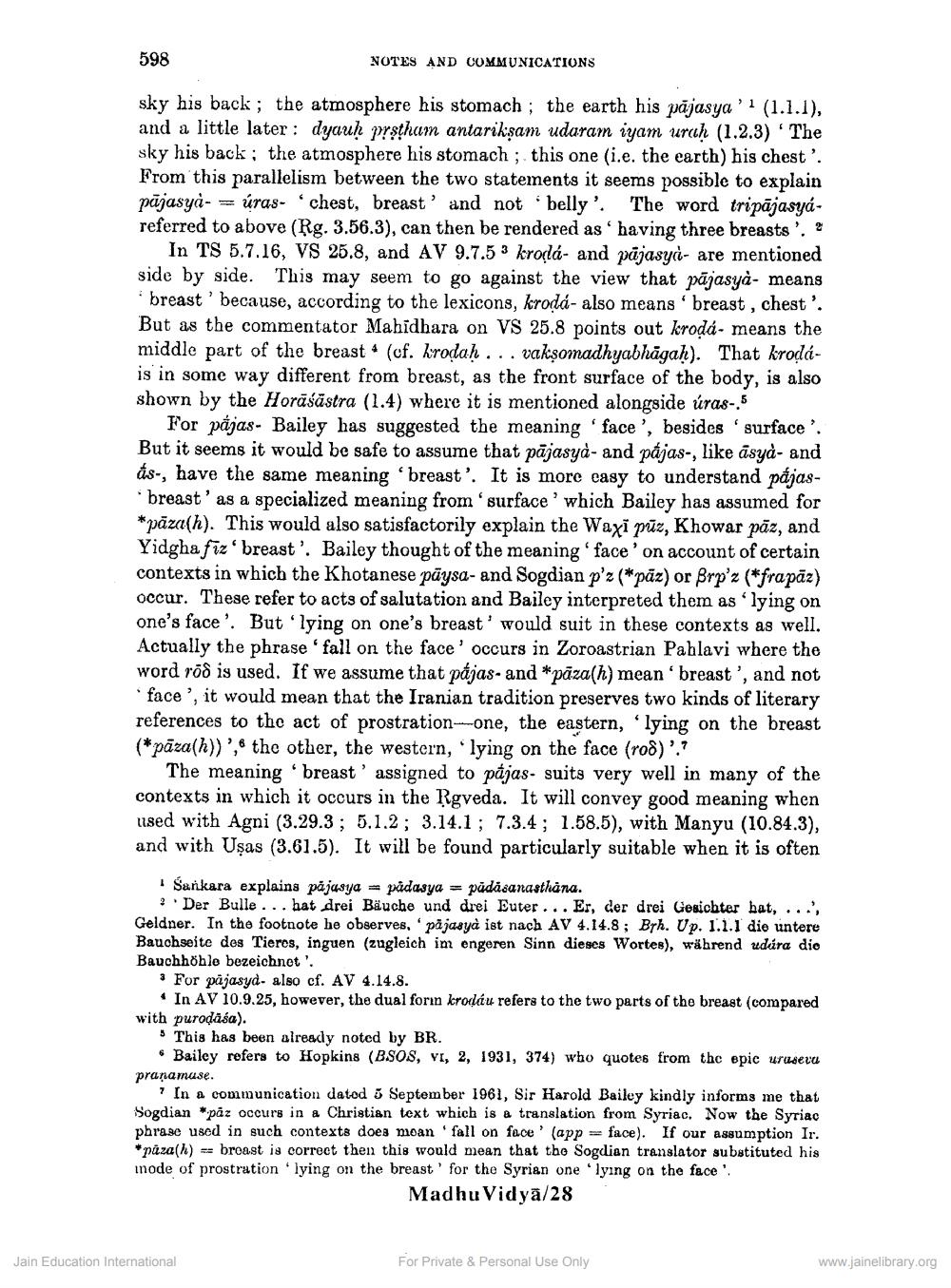________________
598
NOTES AND COMMUNICATIONS
having three breachasya
This may and AV 9.7.53 krodas
sky his back; the atmosphere his stomach; the earth his pājasya'1 (1.1.1), and a little later: dyauh prstham antariksam udaram iyam urah (1.2.3) 'The sky his back: the atmosphere his stomach ; this one (i.e. the earth) his chest'. From this parallelism between the two statements it seems possible to explain pājasya- =úras- chest, breast' and not belly'. The word tripājasyareferred to above (Rg. 3.56.3), can then be rendered as having three breasts '. 2
In TS 5.7.16, VS 25.8, and AV 9.7.5 3 kroda- and pājasyce- are mentioned side by side. This may seem to go against the view that pājasyà- means
breast ' because, according to the lexicons, krodá- also means 'breast, chest'. But as the commentator Mahidhara on VS 25.8 points out krodá- means the middle part of the breast * (cf. krodah ... vaksomadhyabhāgah). That krodáis in some way different from breast, as the front surface of the body, is also shown by the Horāśāstra (1.4) where it is mentioned alongside úras- 5
For pájas- Bailey has suggested the meaning 'face', besides 'surface'. But it seems it would be safe to assume that pājasyd- and pájas-, like āsyd- and ás-, have the same meaning 'breast'. It is more casy to understand påjas
breast' as a specialized meaning from 'surface which Bailey has assumed for *pāza(h). This would also satisfactorily explain the Waxi păz, Khowar pāz, and Yidgha fiz' breast'. Bailey thought of the meaning 'face' on account of certain contexts in which the Khotanese pāysa- and Sogdian p'z (*pāz) or Brp'(*frapāz) occur. These refer to acts of salutation and Bailey interpreted them as lying on one's face'. But 'lying on one's breast' would suit in these contexts as well. Actually the phrase 'fall on the face occurs in Zoroastrian Pahlavi where the word röd is used. If we assume that pájas- and *pāza(h) mean breast', and not * face', it would mean that the Iranian tradition preserves two kinds of literary references to the act of prostration-one, the eastern, lying on the breast (*pāza(h))',& the other, the western, lying on the face (ro8)'.?
The meaning breast' assigned to pájas- suits very well in many of the contexts in which it occurs in the Rgveda. It will convey good meaning when used with Agni (3.29.3; 5.1.2; 3.14.1 ; 7.3.4; 1.58.5), with Manyu (10.84.3), and with Uşas (3.61.5). It will be found particularly suitable when it is often
Sankara explains pājasya = pidasya = pūdisanasthana.
?Der Bulle... hat Arei Bäuche und drei Euter... Er, der drei Gesichter bat, ..., Geldner. In the footnote he observes, pājasyà ist nach AV 4.14.8; Brh. Up. 1.1.1 die untere Bauchseite des Tieros, inguen (zugleich im engeren Sinn dieses Wortes), während udara die Bauchhöhle bezeichnet'.
For påjasyd- also cf. AV 4.14.8. • In AV 10.9.25, however, the dual forin krodáu refers to the two parts of the breast (compared with purodaśa).
$ This has been already noted by BR.
• Bailey refers to Hopkins (BSOS, VI, 2, 1931, 374) who quotes from the epic uruseva pranamuse.
? In a communication datod 5 September 1961, Sir Harold Bailey kindly informs me that Sogdian "paz occurs in a Christian text which is a translation from Syriac. Now the Syriac phrase used in such contexts does moan 'fall on face' (app - face). If our assumption Ir. #paza(1) -- broast is correct then this would mean that the Sogdian translator substituted his inode of prostration lying on the breast' for the Syrian one lying on the face
Madhu Vidyā/28
Jain Education International
For Private & Personal Use Only
www.jainelibrary.org




